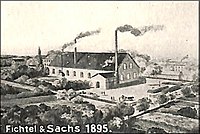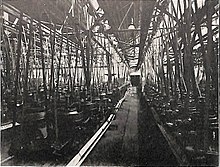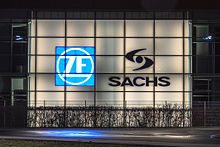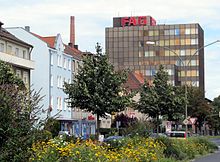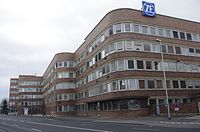Schweinfurt industrial history
The industrial history of Schweinfurt looks back over 240 years. It began in 1770 and has its roots in the Protestant imperial city of Schweinfurt , a center of humanism and the Enlightenment , surrounded by the dioceses of Würzburg and Bamberg .
All sectors, with the exception of heavy industry , were or are represented in the city, including paints, chemicals, electronics, films, shoes, textiles, food, luxury goods, health and of course metal processing. The electrical and textile industries were or still exist to a small extent, which spared the city from deindustrialization , in contrast to the former Franconian industrial centers of Nuremberg , Fürth , Aschaffenburg and Hof . Only Erlangen is otherwise still of great industrial importance in Franconia , but i. Ggs. Zu Schweinfurt industrially without a history. In terms of its industrial past and present, Schweinfurt can only be compared with Munich and Augsburg today in Bavaria .
The development of the Schweinfurt large-scale industry was shaped by brilliant people, such as Ernst Sachs , the protagonist of globalization - as early as 1903. But also by "business crime" and pure capitalism , with the formation of a cartel and hostile takeovers , fueled by two world wars. The city became the European center of the rolling bearing industry and is still considered the world capital of ball bearings to this day . The big three FAG Kugelfischer , Fichtel & Sachs and SKF were among the 100 largest industrial companies in Germany in the 1960s.
In addition to the opportunities, the crises caused by globalization also occurred more quickly in Schweinfurt than elsewhere in Germany. As early as the early 1970s, Japanese companies wanted to bring the local ball bearing location to its knees by dumping prices with the only globally relevant roller bearing center around Kobe besides Schweinfurt . That led to a serious crisis. The great wave of globalization hit the city back in 1992, harder and a year earlier than the rest of Germany. When this was fully covered by unemployment , Schweinfurt was looking for skilled workers again in 1994, as the only place in Germany. The city became an indicator in which new developments were more likely than elsewhere. At the beginning of the 21st century, Schweinfurt finally became the most important large-scale industrial center in Northern Bavaria.
Overview of the inventions
- 1853: Pedal crank - bicycle by Philipp Moritz Fischer .
- 1883 ball grinding of Friedrich Fischer .
- 1889: bicycle freewheel of Ernst Sachs .
- 1903: Ernst Sachs coaster brake .
- 1920: Modern football with check valve by Fritz Stöcklein.
- 1986: Micro-CHP unit from Fichtel & Sachs .
The invention of the pedal crank bicycle by PM Fischer was not the beginning of the large industrial development of Schweinfurt, but only the invention of the ball grinder by his son Friedrich Fischer. Bicycle freewheel and coaster brake were finally integrated into the torpedo freewheel hub (1903) by Fichtel & Sachs after their invention . The hub gear was not invented by Fichtel & Sachs, but developed over decades.
The modern inline skates were not invented in Schweinfurt either, but in 1978 SKF brought them onto the market in improved quality (especially ball bearings) (Speedy) . They only became popular in Schweinfurt, with inline skating races, and were forgotten again. When the trend came from the USA in the early 1990s, the first impulses came from SKF again in Germany. The deep groove ball bearings used remained the same as with Speedy .
In 1986, Fichtel & Sachs began developing prototypes for micro-cogeneration units and started 10-year field trials. The Senertec company in Schweinfurt emerged from Fichtel & Sachs and began production of the roof in 1996 , the first micro-cogeneration unit ready for series production.
Industrial history
18th century
Colors and food (I)
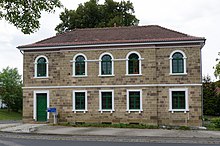

The industrialization of the city began in 1770 , with a continuous 250 year industrial history to this day, without the phases of deindustrialization that happened to all other Franconian industrial cities.
The chemical and paint industry began in 1770 with the construction of Wolf's white lead mill on today's weir systems . According to Ferdinand Gademann (1880–1969), it is said to have been the oldest German white lead factory . In 1780 it was taken over by Johann Martin Schmidt, with an attached production of vinegar . In 1788 Johann Georg Gademann (1754–1813), who came from one of the oldest Schweinfurt families, started producing white lead and founded the first Bavarian factory for mineral paints , the Gademann & Co paint factory . From 1792 she was based in the suburb of Niederwerrn . By 1833 at the latest, the factory was located on the Börklein (also: Gademannscher Hügel ) in Schweinfurt, south of the Main , at the junction of the Saumain . Under Carl Friedrich Gademann (1846–1910), the grandson of Johann Georg, the factory had around 120 employees around 1900.
19th century: first half
Food (II)
The city's further industrial development is closely linked to the name Wilhelm Sattler , the richest and most successful entrepreneur in Bavaria at the time, who also combined this with social commitment. In 1810 he developed a substitute for sago , which was exported to France during the time of the continental barrier . Around 1825, Sattler built a sugar factory within the city walls, in place of today's Holy Spirit Church .
Schweinfurt green
In the first half of the 19th century Schweinfurt was a center of the German paint industry. Sattler was the first to produce and export industrially the (highly toxic) Schweinfurt green , which u. a. was also called the Parisian Green , in all parts of the world. In 1814 production was relocated to the Schonungen suburb . With the advent of aniline paints ( BASF , Hoechst AG ), however, the Schweinfurt green lost its importance from 1860 onwards. Today there are still a few medium-sized companies in this branch.
19th century: second half
Gelatin and films
The German Gelatine Factory (1872 / 1889–1944), in the western outskirts of today's inner city , produced gelatine as food. The production of emulsion gelatine for photochemical purposes was later started and the plant was considered the largest factory in the world in this field in the 1920s.
The buildings were destroyed in the war and the factory was never rebuilt. In the 1960s the factory ruins were blown up, large residential complexes and a large new building for the Federal Employment Agency were built on the site .
Rise of the rolling bearing industry
In 1883 the city began to develop on a large scale with the invention of the ball grinder by Friedrich Fischer, based on the principle still used today. With it, accuracies of 0.02 millimeters have already been achieved. The device was further developed by Wilhelm Höpflinger . This idea is considered to be the historic start of the rolling bearing industry.
But Fischer claims success for himself, which is why Höpflinger and Fischer's silent partner Engelbert Fries left the Friedrich Fischer company and founded their own company, Fries & Höpflinger . Höpflinger copied Fischer's machine and had the patent protected in 1890. Fischer sues, his patent is recognized, but Höpflinger receives license-free usage rights.
Creation of the big three
Independently of this, the inventor Ernst Sachs and the businessman Karl Fichtel founded the company Schweinfurt Precision Ball-Bearings Fichtel & Sachs 5 years later . This created the big three : Kugelfischer (1890), Fries & Höpflinger (1890) and Fichtel & Sachs (1895), which made Schweinfurt the center of the European rolling bearing industry and also a world-renowned center for bicycle components (see: Overview of the inventions ) .
20th century: first half
First global player
Ernst Sachs was the first global player to have a component patented worldwide for the first time in 1903 with the torpedo freewheel hub, without which nobody could build a modern bicycle.
First World War
The First World War brought another boom , as the first modern war and material battle in history.
Reorganization of the rolling bearing industry
The reorganization of the German rolling bearing industry, designed by Ernst Sachs and Georg Schäfer (II) in 1929, turned out to be the course for the location. Sachs sold its rolling bearing division (Fichtel & Sachs Plant 1 on Schillerplatz; see picture at the beginning of the article) to the Swedish SKF , which had been pursuing an aggressive expansion strategy since 1925. SKF also acquired Fries & Höpflinger AG and also plants in Berlin and Krefeld , which merged to form Vereinigte Kugellagerfabriken AG (VKF, from 1953 SKF GmbH), with its headquarters in Schweinfurt. On the supervisory board sat u. a. Ernst Sachs, Peter Klöckner , Fritz Thyssen and Günther Quandt . VKF dominated 80% of the German market. The only remaining German competitor was FAG Kugelfischer. SKF has now gradually shut down the plants in Berlin and Krefeld. The German rolling bearing industry was now completely controlled from Schweinfurt, from two headquarters that were only 500 m apart.
Depression and recovery

| Employee | 1928 | 1932/33 | 1938/39 | 1944/45 |
|---|---|---|---|---|
| Fichtel & Sachs | 6,800 | 2,300 | 6,700 | 7,100 |
| Fries & Höpflinger | 1,900 | - | - | - |
| FAG puffer fishers | 2,200 | 2,800 | 8,000 | 11,700 |
| VKF ( SKF ) | - | 2,000 | 6,000 | 8,000 |
From 1934 onwards, the Depression was followed by an economic boom supported by job creation programs and military armaments. Fichtel & Sachs also started producing small motors, clutches and shock absorbers , which Ernst Sachs financed with the proceeds from the sale of the rolling bearing division to SKF. This enabled important areas of the automotive supplier industry to be covered within the city . Numerous car parts did not leave the city limits until the post-war decades, from production to wholesale to installation in the car workshop.
Also for the urban order, the focus on had The Big Three positive. Until around 1900 the city center, like in many other German cities, was surrounded by factories and chimneys in almost all directions, but industry was now concentrated in the southwest around the main train station and was now largely in the Oberndorf district.
Second World War
During the Second World War , the city was repeatedly the target of Allied bomber attacks due to the concentration of rolling bearing production, which was essential for the war effort . Over 60% of the total production of the German Empire in this key industry was in Schweinfurt. Production was maintained with great effort, with factories partially protected against bombs like bunkers. Parts of the production were relocated to other locations, including Eltmann , Ebern and Elfershausen . 1942 began Todt Organization under the code name Construction Neustadt the plaster tunnel Neckarzimmern to expand massively for the bearings production of sales promotion (since 1953 SKF). In 1944, large production facilities with administrative and permanent staff from the main plant in Schweinfurt and the Bad Cannstatt plant were relocated here. Forced laborers from the Neckarelz concentration camp in the immediate vicinity were used to drive the tunnel and to assist in production. After the war, the Americans arranged for the machines to be transported back to Schweinfurt and to the Bad Cannstatt branch (closed in 2001). The number of forced laborers peaked at 4400 at the end of 1943 , and a total of 4500 prisoners of war were used.
20th century: second half
Economic miracle
Around 1965, Schweinfurt's large-scale industry reached its all-time high with over 30,000 employees. The big three FAG Kugelfischer, Fichtel & Sachs and SKF were among the 100 largest industrial companies in Germany at that time.
Globalization and structural change
As early as the beginning of the 1970s, the number of employees fell sharply, in one German exception, due to Japanese dumping prices (see: Article introduction). After consolidation in the 1980s, the biggest losses were in 1992/93, with 13,000 jobs and the city hit the German headlines.
Since the 1990s there has been a structural change in the local roller bearing industry, away from cheap mass production and towards specialization and more complex research (see: Schweinfurt, Phönix aus der Asche ).
21st century
Hostile takeover of FAG by Schaeffler
In 2001 there was the third hostile takeover in German post-war history. The DAX company FAG Kugelfischer was taken over by the previously unknown INA-Schaeffler from Herzogenaurach , which had only existed since 1946, and was integrated into the Schaeffler Group in 2006 . The FAG brand was retained. INA and FAG together became the second largest rolling bearing group in the world, after SKF. Schweinfurt became the seat of Schaeffler Technologies GmbH & Co. KG. The largest plants of the two largest rolling bearing groups in the world were located in Schweinfurt, but the corporate headquarters were now both outside the city, in Gothenburg and Herzogenaurach.
Fichtel & Sachs AG was sold to Mannesmann from 1987 by Gunter Sachs and members of the Sachs family . As a result of the Mannesmann takeover by Vodafone , the company was transferred to a consortium led by Bosch and Siemens in 2000 . In 2001, Sachs was sold to ZF Friedrichshafen , renamed ZF-Sachs and merged with ZF Friedrichshafen in 2011. The company name Sachs disappeared, the Sachs brand is continued.
IBM at FAG
The I nformationssysteme B eratungs- and B etriebsgesellschaft mbH ( IBB ) was in 1993 from a outsourcing project of IBM with FAG ball Fischer forth. 250 IT employees changed employers. In 2003 IBB was renamed IBM Business Services GmbH . At that time it employed 1,100 people at five locations in Germany, with its headquarters in Schweinfurt. In 2005 the locations in Schweinfurt and Hanover were closed and jobs were relocated to low-wage countries.
New boom and other industries
In the years that followed, the Deutsche Star, now Bosch Rexroth , who had been based here since 1909 , gained in importance. With the construction of a large plant for linear technology in the west of the port, with a workforce of 2,200 (2008) At the same time, SKF Linearsysteme GmbH set up a plant in the new Maintal industrial and commercial park . Thus, in addition to rolling bearings, the city has now also become a center for linear motion technology.
In 1979 Fresenius Medical Care acquired a small medical technology plant in the industrial area Hafen-West. In the course of time it grew to become the second largest German plant of the DAX group and the world's largest manufacturer of dialysis machines , with 1,100 employees (2008).
After the peak in the economic miracle with 30,000 employees in local large-scale industry and a low of 15,000 in 1993, 22,000 people were employed again by 2015. Since then, the industry has not focused solely on the big three , but has been more broadly based. .
Energy transition and digital factory
The energy transition , with large bearings for wind turbines , brought the local roller bearing industry another new business area. SKF opened the world's most powerful large bearing test center in 2017.
In the Schaeffler plant in Schweinfurt, the headquarters of the Industry division and the center of mechatronics , the Industry 4.0 process and a digital learning factory have been located. (see also: i-Campus Schweinfurt, i-Factory ).
Research and Development
Finally, there was an increasing change, away from the classic working-class city, towards a center for research and development, with an ever-increasing need for engineers. After the labor shortage of the 1960s, which the local big industry faced with thousands of guest workers, and unemployment in the 1970s and 1990s, the shortage of skilled workers has now become the predominant problem. That is why the international i-Campus Schweinfurt university campus started in 2014 .
See also: Schweinfurt, economy
Industrial architecture and cityscape
The Schweinfurt cityscape is still shaped today by its industry. Many buildings were built during one of the waves of industrialization that the city experienced since the 18th century or were at least affected by these developments. The people of Schweinfurt were aware of their special skyline early on , so that when the Gademann paint mill, built in 1783, burned down in 1921, people mourned the "landmark of our city, which blended in happily with the landscape of the splendid river section".
The paint mill was rebuilt in the style of its predecessor and still characterizes the banks of the Main with its mansard hipped roof as a so-called “green house”. In the first half of the 19th century, industrialization along the Schweinfurt Main section continued. With the first modern technical building, an American art mill , a tale, fulling and grinding mill and a five-story high spinning mill, the so-called “Main- Etablissement ” was created between 1841 and 1846 . The ensemble still exists today, but was reconstructed after a fire in 1911 and is no longer used industrially.
The constant progress in industrial processes in the second half of the 19th century led to what is probably the most extensive change in the Schweinfurt cityscape to this day. The so-called “Spitalquartier” around today's Heilig-Geist-Kirche lost its medieval small-scale structure and instead gave way to an almost metropolitan area. The reason for this was the large factories of Fichtel & Sachs (1895) south and Kugelfischer (1896) in the north of the railway line.
The townscape was changed rather indirectly by the private houses of the company founders. Christian Friedrich Gademann had a castle-like building built in the style of historicism on Bergstrasse in 1896 . The villa by architect Bruno Specht , with its decorative gables and tower, leaned closely against the city's historic town hall and marked the start of the construction of further villas. Carl Christian Giegler had a small villa built on Deutschhöferstrasse in 1893/1894. More industrialists from Schweinfurt followed.
Schweinfurt is still characterized today by the machine and boiler house of the Fichtel & Sachs company. The building was built in 1924 at Ernst-Sachs-Straße 62 and suddenly changed the cityscape with its 83.3 m high chimney. The tower, a special shape with the water tank at a height of 32 m, can still be considered a landmark today, even if its height was reduced. In the 1920s, 1930s and 1940s, the Schweinfurt plant was mainly characterized by brick as a material.
The financial power of the Schweinfurt industrial elite also increasingly attracted well-known architects to the Main during the Weimar Republic . Such was Roderich Fick worked for the founder Ernst Sachs and created the Ernst-Sachs-Bad, as sinnfälligstes example of the patronage of the great industrialists. From 1933 Paul Bonatz worked in Schweinfurt on the first construction phase of the administrative building of Fichtel & Sachs. The building at Ernst-Sachs-Straße 62 was “functional, simple and dignified” and with its four storeys in forms of classical modernism still characterizes the area today (It was increased by one floor at the end of the 1960s). Now the other large industrial companies followed suit. Kugelfischer had a five-story building erected in 1935, and Hall F was also built in 1939 by the architect Emil Rudolf Mewes .
The Second World War then destroyed or badly damaged many of the iconic industrial buildings. In 1945, 70% of all SKF facilities were destroyed. However, everything was quickly repaired in the post-war period . After consolidation in the economic miracle, SKF succeeded in building another building that would shape the cityscape in 1960 and 1962. The administration high-rise with a height of 55 m was built according to the plans of August Kubitza. After its construction, it was the tallest office building in Lower Franconia and still shapes the Schweinfurt skyline today.
At the end of the 20th century, the Schweinfurt-based companies only implemented minor architectural innovations. The company Riedel Bau engaged the architect Wolfgang Schefbeck for a new building in the port of Schweinfurt in 1996. A modern reinforced concrete skeleton construction was created with many glass additions. Between 2013 and 2015 the company Georg Lesch Rohstoffhandel had a new office and production building built, also in the harbor, which with its rust-red COR-TEN steel plates is intended to be a reminder of the company's products. In 2008, large parts of the fallow factory areas were demolished as a result of the urban redevelopment west. Only a factory gate from Fichtel & Sachs from 1905/1910 was displayed, which gives an indication of the industrial history of Schweinfurt.
Industrial museums and monuments
Museums
The construction of a large museum of Schweinfurt's industrial history has been under discussion for a long time, in which the countless exhibits currently located in many places can be shown together.
So far, a larger and a smaller museum and a room in another museum provide insights into industrial history. The Small Industrial Museum is located in the old town , in the spinning mill on Gutermann-Promenade on the Main . It is open from March to November on the second and fourth Saturday of each month, from 2 p.m. to 6 p.m. and during city festivals. The City History Museum in the old town, with the world's first pedal crank bike, is currently (2018) closed due to extensive renovations. The ZF Sachs Museum in Oberndorf shows the company history of Fichtel & Sachs on a large scale. The museum is located within the main factory (today ZF Werk-Nord). Admission and tours only after registration.
Monuments
In the city, especially on the Main Promenades, numerous monuments testify to the long industrial history. At the city theater there is a duplicate of the hub bearing from FAG Kugelfischer for the largest, 208 m high Ferris wheel in the world (see: FAG Kugelfischer, Peking Wheel ).
See also
literature
- Thomas Horling: Cartel and Foreign Capital. The German rolling bearing industry in 1925–1932. In: Yearbook for Franconian State Research. Volume 66, 2006, pp. 521-562.
- Leonardo Calossi: Comments on internment in Germany 1943–45 - forced laborer with Kugelfischer . Verlag Rudolf & Enke, Ebertshausen 2003, ISBN 3-931909-08-5 .
- Nicolette Baumann: Office and production building in Schweinfurt. (= Baukultur Guide. 101). Amberg 2016.
- Klaus Rehberger: Wilhelm Sattler - 1784–1859 chemist, businessman and citizen . Reimund Maier Verlag, Schweinfurt 2014, ISBN 978-3-926300-66-9 .
- Erich Schneider: Schweinfurt and its monuments - architecture-art-technology . Verlagshaus Weppert, Schweinfurt 2015, ISBN 978-3-9803695-9-6 .
- Paul Ultsch: Back then in Schweinfurt - Volume 2 - Development into an industrial city . Book and idea publishing house, Schweinfurt 1983, ISBN 978-3980048026
Web links
- Peter Hofmann: Schweinfurt Guide / Industrial History
- Video: chronoshistory: Flight over the destroyed Berlin (0:00 to 2:00) and the destroyed Schweinfurt industrial area (2:00 to 6:00; in color)
- Video: Aerial photos360: Schweinfurt industrial area from the air (2:10)
Individual evidence
- ^ A b Peter Hofmann: schweinfurtfuehrer.de/Industrieunternehmen by sector. Retrieved November 2, 2018 .
- ↑ presseportal.de. Retrieved April 15, 2016 .
-
↑ Schweinfurt became the largest location in Northern Bavaria in terms of the number of employees in large-scale industry. As a result of the strong de-industrialization of Nuremberg, with a total of around 17,500 employees already in 2008/10, as follows: Siemens 9,000 (2008), MAN 3,500 (2010), Diehl 3,000 (2010), Bosch 2,000 (2010), and this trend has continued since then falling. Siemens had 22,000 employees in Erlangen in 2008, and the trend has been falling since then. FAZ.de: Siemens cuts 5,250 jobs in Germany. Retrieved August 13, 2018 . Süddeutsche Zeitung.de: decline of an industrial site. Retrieved August 13, 2018 . Employees in the five major Schweinfurt companies in 2017/18 a total of approx. 22,000, as follows: ZF Friedrichshafen 9,500 (2017), Schaeffler 5,400 (2017, Bayerischer Rundfunk: number of employees at the Schweinfurt location increased by around 240 , March 7, 2018), SKF 4,100 ( 2018), Bosch Rexroth approx. 2,000, Fresenius Medical Care 1,200 (2018, Fresenius information on the production and development site in Schweinfurt)
- ↑ In Ggs. Zu Pierre Michaux (1861) PM Fischer did not bring his invention exhibited in the Schweinfurt Museum for City History to the public, which is why he is still not mentioned in many sources on bicycle history. The alleged previous inventions by Baader (1825) and Heinrich Mylius (1845) are controversial and unproven: foelss.de: The development of the bicycle. Retrieved March 28, 2018 .
- ↑ a b c maschinenmarkt.de: thriller about the ball milling machine. June 3, 2015. Accessed October 29, 2018 .
- ↑ a b FahrradZukunft.de; History of Fichtel & Sachs, issue 17, February 2014. Retrieved October 24, 2016 .
- ↑ The man who stole the ball from the ball. In: Schweinfurter Tagblatt. August 21, 2015.
- ↑ a b History of combined heat and power plants. Retrieved April 4, 2016 .
- ^ TNS Frankfurt Forum. Retrieved October 29, 2018 .
- ^ A b Paul Ultsch: Back then in Schweinfurt . Volume 1: When the city wall was still a boundary . Book and idea publishing company, Schweinfurt 1982, ISBN 3-9800480-1-2 , p. 80
- ↑ Peter Hofmann: schweinfurtfuehrer.de/Geschichte 1700–1800. Retrieved April 27, 2019 .
- ↑ Federal Archives: Johann Georg Gademann. Retrieved November 3, 2018 .
- ^ Peter Hofmann: schweinfurtfuehrer.de/Gademann. Retrieved November 3, 2018 .
- ↑ Bayerischer Rundfunk, television: "Between Spessart and Karwendel"
- ↑ Bavaria Atlas of the Bavarian Surveying Administration, historical map.
- ^ Peter Hofmann: schweinfurtfuehrer.de: Gelatine factory. Retrieved November 3, 2018 .
- ^ Economy in Main Franconia: Patented 125 years ago. August 2015, p. 88.
- ^ Schaeffler in Germany. Retrieved October 23, 2018 .
- ↑ Wilfried Rott: Sachs - entrepreneurs, playboys, millionaires . Blessing, 2005, ISBN 3-89667-270-3 .
- ↑ The number of 4,500 prisoners of war relates to the period from Aug. 1941 to Oct. 1944. As with the forced laborers, there was also a fluctuation among the prisoners of war. The number of prisoners of war simultaneously employed in the Schweinfurt industry cannot be precisely determined due to a lack of data. As with the forced laborers, the peak was probably reached at the end of 1943. Cf. Uwe Müller, The employment of foreign civilian workers and prisoners of war in the Second World War in Schweinfurt. Figures from the city archives, in: “Towards people”. Ecumenical and historical not only from Schweinfurt. For the 70th birthday of Dean i. R. Johannes Strauss, ed. by Ernst Petersen, Schweinfurt 2001, p. 119.
- ↑ With the takeover of FAG Kugelfischer in 2001, Schaeffler became the second largest rolling bearing manufacturer in the world, in: Wirtschaft in Mainfranken: With an ingenious idea for a global corporation , August 2016, p. 78.
- ↑ computerwoche.de: IBB is renamed. January 10, 2003. Retrieved October 29, 2018 .
- ↑ stern.de: Plant closings in Schweinfurt and Hanover. May 6, 2005. Retrieved October 29, 2018 .
- ↑ SKF Large Bearing Test Center: Computer animation (video 2:20 min.). Retrieved May 1, 2018 .
- ↑ Schweinfurter Tagblatt. May 8, 2018.
- ↑ Erich Schneider: Schweinfurt and its monuments. P. 179 f.
- ↑ Martin Matl among others: Architectural Guide Schweinfurt. Buildings after 1945. p. 18.
- ↑ Erich Schneider: Schweinfurt and its monuments. P. 251.
- ↑ Martin Matl among others: Architectural Guide Schweinfurt. Buildings after 1945. p. 20.
- ↑ Erich Schneider: Schweinfurt and its monuments. P. 351.
- ^ Nicolette Baumeister: Office and factory building in Schweinfurt. P. 10.
- ↑ Erich Schneider: Schweinfurt and its monuments. P. 355.
- ↑ Peter Hofmann: schweinfurtfuehrer.de/Kleines Industriemuseum. Retrieved October 20, 2018 .
- ↑ Peter Hofmann: schweinfurtfuehrer.de/SACHS-Ausstellung der ZF Friedrichshafen AG. Retrieved October 20, 2018 .
